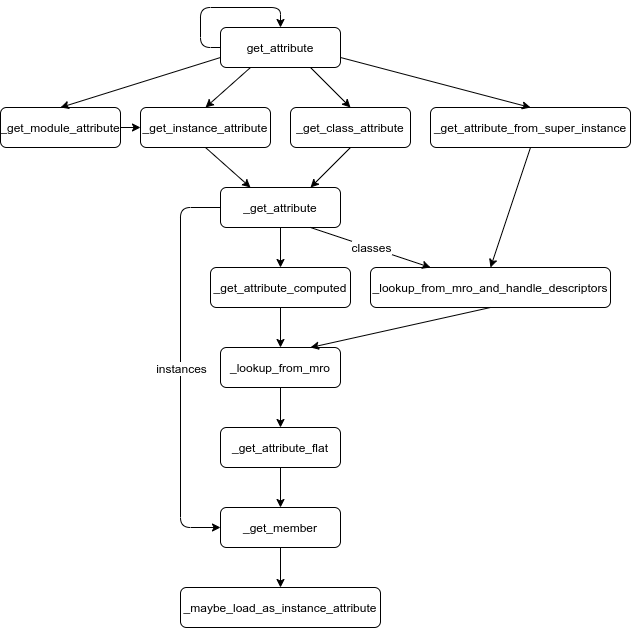pytype
A static type analyzer for Python code
Home
Developer guide
Workflow
• Development process
• Python version upgrades
• Supporting new features
Program analysis
• Bytecode
• Directives
• Main loop
• Stack frames
• Typegraph
Data representation
• Abstract values
• Attributes
• Overlays
• Special builtins
• Type annotations
• Type stubs
• TypeVars
Configuration
Style guide
Tools
Documentation debugging
View the Project on GitHub google/pytype
Hosted on GitHub Pages — Theme by orderedlist
Attributes
Introduction
The attribute module handles getting and setting attributes on abstract values. It is mostly used to:
- analyze the
LOAD_ATTRandSTORE_ATTRopcodes, and - look up magic methods that are needed to perform certain operations - e.g.,
__init__for instance creation and__setitem__for modifying a dictionary.
Terminology
We will refer to the object on which an attribute is being get or set as the target object.
Implementation
attribute has two public methods: get_attribute and set_attribute.
set_attribute
We’ll start by looking at set_attribute, since it’s by far the simpler of the
two top-level methods:

set_attributerecursively calls itself as needed to unpack the target object. For example, when passed a union,set_attributeiterates through the union’s options and calls itself on each one.set_attributethen calls_set_member, which first calls_maybe_load_as_instance_attributeto make sure the requested attribute has been lazily loaded into the object’smembersdict, then modifies the appropriatemembersentry.
get_attribute
get_attribute is considerably more complicated, due to the lengths it goes to
in order to emulate the behavior of the Python interpreter:

- Like
set_attribute,get_attributerecursively calls itself to unpack the target object. -
Once the object has been unpacked, it is either a module, class instance, class, or super instance (the result of a
super()call). The corresponding helper method is called.a.
_get_module_attributeforwards to_get_instance_attribute.b.
_get_instance_attributeand_get_class_attributeforward to_get_attribute.c.
_get_attribute_from_super_instancedetermines the super class and calls_lookup_from_mro_and_handle_descriptorson it. -
Python classes can define a magic method,
__getattribute__, that is called unconditionally to implement attribute access, as well as a fallback method,__getattr__, that is only called when normal attribute lookup fails. (See the Python data model documentation for more information.) To mimic this,_get_attributefirst calls_get_attribute_computed("__getattribute__"), then calls either_get_memberor_lookup_from_mro_and_handle_descriptorsdepending on whether the target object is a class instance or a class, and finally calls_get_attribute_computed("__getattr__"). -
Both
_get_attribute_computedand_lookup_from_mro_and_handle_descriptorsuse_lookup_from_mroto do attribute lookup on a class. The latter walks the class’s MRO, calling_get_attribute_flat- which in turn calls_get_member- to check for the attribute on the class and its bases. - Similar to
_set_member,_get_memberuses_maybe_load_as_instance_attributeto force lazy loading and then checks themembersdict for the requested attribute.
get_special_attribute
Occasionally, an abstract class needs to bypass normal attribute lookup. In such
cases, the class can implement a get_special_attribute method whose return
value will be immediately used. For example, HasSlots returns the
custom method implementations in its slots rather than the underlying
PyTDFunction objects.
valself
attribute.get_attribute takes an optional valself parameter, a binding to an
abstract value related to the target object. When to pass valself and what
value to use can be tricky:
- If the target object is an instance of a class, rather than a class itself,
then
valselfis strictly optional and should be a binding to the target object. When given,valselfwill be included in the origins of the returned variable and therefore be taken into account in typegraph solver queries. - If the target object is a class, then
valselfis interpreted roughly as follows:-
If
valselfis a binding to an instance of the target class, then the attribute lookup will ignore the class’s metaclass. For example, with:class Foo(type): def f(cls): pass class Bar(metaclass=Foo): passget_attribute(node, Bar, 'f', valself=Binding(Instance(Bar)))will returnNonedespitefexisting onFoo. The reasoning is that if the original query were for an attributefon an instance ofBar, taking the metaclass into account would be unexpected. - If
valselfis a binding to the class, then the attribute lookup will use the metaclass. Soget_attribute(node, Bar, 'f', valself=Binding(Bar))will returnFoo.f, as we’re treatingBaras not only a class but also an instance of its metaclass. - If
valselfisNoneand we are looking up__getitem__, then the class is treated as a type annotation. - Otherwise, if
valselfisNone, then attribute lookup will behave the same as in case (1), except that methods will be returned unbound, since there is no instance of the class to bind to.
-